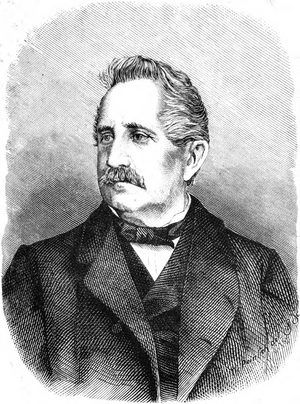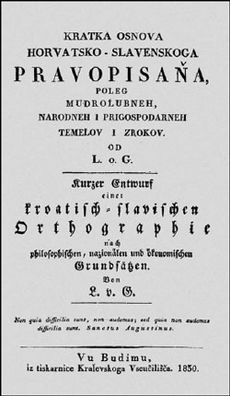Ljudevit Gaj facts for kids
Quick facts for kids
Ljudevit Gaj
|
|
|---|---|
 |
|
| Born |
Ludwig Gay
8 August 1809 Krapina, Kingdom of Croatia, Austrian Empire
|
| Died | 20 April 1872 (aged 62) Zagreb, Kingdom of Croatia-Slavonia, Austria-Hungary
|
| Resting place | Mirogoj Cemetery, Zagreb, Croatia |
| Occupation | Linguist, politician, journalist, writer |
| Known for | Gaj's Latin alphabet |
| Movement | Illyrian movement |
| Spouse(s) |
Paulina Krizmanić
(m. 1842) |
| Children | 5 |
Ljudevit Gaj (born Ludwig Gay; August 8, 1809 – April 20, 1872) was an important Croatian linguist, politician, journalist, and writer. He was a key leader of the Illyrian Movement, which aimed to unite South Slavs.
Contents
Who Was Ljudevit Gaj?
Ljudevit Gaj was a very important person in Croatian history. He helped create a standard way of writing the Croatian language. He also started newspapers that spread new ideas and helped unite people.
Early Life and Education
Ljudevit Gaj was born in Krapina, a town in what was then the Austrian Empire, on August 8, 1809. His father was from a German family, and his mother was also of German background.
Ljudevit went to high school in different cities like Varaždin, Zagreb, and Karlovac. He then studied philosophy in Vienna and Graz, finishing in 1828. Later, he studied law in Budapest from 1829 to 1831.
Creating a Croatian Alphabet
Even when he was young, Gaj started publishing his writings. In 1826, he wrote a small book in German about castles near his hometown.
In 1830, Gaj published a very important book called "Concise Basis for a Croatian-Slavonic Orthography." This book was about how to write the Croatian language correctly. Before this, different Croatian writers used different ways to write certain sounds.
Gaj wanted to make it easier for everyone to read and write Croatian. He looked at how the Czech language was written and used similar ideas. He created a system where each sound in Croatian had its own letter or a special combination of letters, like lj and nj. This system is known as Gaj's Latin alphabet.
Spreading News and Ideas
Because of his work on the alphabet, Gaj became famous across the country. In 1834, he got permission from the government to start a Croatian daily newspaper. This was a big achievement!
On January 6, 1835, his newspaper, Novine Horvatske ("The Croatian News"), was first published. A few days later, a literary magazine called Danicza horvatzka, slavonzka y dalmatinzka ("The Croatian, Slavonian, and Dalmatian Daystar") also appeared.
In 1836, the names of these publications changed to Ilirske narodne novine ("The Illyrian People's News") and Danica ilirska ("The Illyrian Morning Star"). This was because people at the time believed that ancient Illyrians were ancestors of today's South Slavs.
Gaj was also a poet. His most famous poem, "Još Hrvatska ni propala" ("Croatia is not in ruin yet"), was written in 1833.
His Later Life and Impact
Ljudevit Gaj died in Zagreb, which was then part of Austria-Hungary, on April 20, 1872. He was 62 years old.
His work on the alphabet had a lasting impact. The Latin alphabet used for the Serbo-Croatian language today is based on Gaj's system. The Slovenian alphabet also uses a similar system.
In 1842, Gaj married Paulina Krizmanić in Marija Bistrica. They had five children: a daughter named Ljuboslava, and four sons named Velimir, Svetoslav, Milivoje, and Bogdan.
Gaj's legacy is still remembered in Croatia. In 2008, more than 200 streets in Croatia were named after him, showing how important he was to the country.
Images for kids
See also
 In Spanish: Ljudevit Gaj para niños
In Spanish: Ljudevit Gaj para niños



